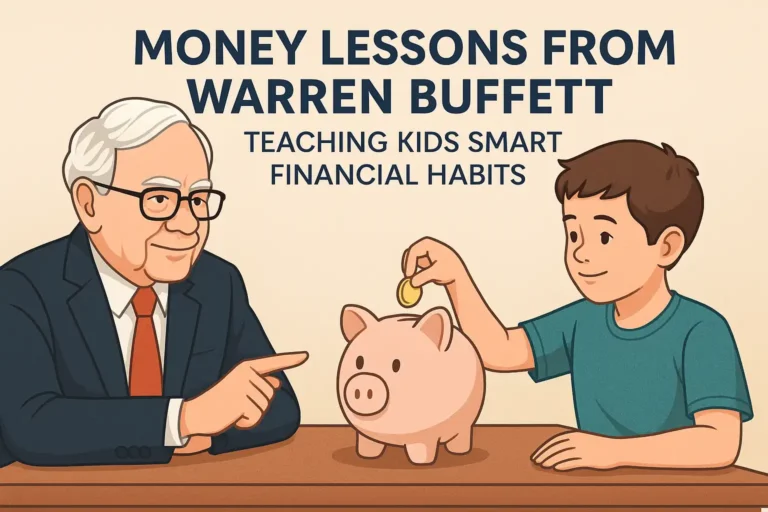Why Fast Savings for Kids Is Not Just a “Nice-to-Have” Anymore
Imagine this: Your child turns 18, ready to chase big dreams—college, a car, even starting a business. But instead of scrambling for scholarships or taking out hefty loans, you confidently say:
“We have got it covered.”

You do not need a six-figure salary. You do not need to sacrifice your own financial health.
All you need is a plan that is smart, fast, and sustainable.
This blog post is your action-packed blueprint to building a powerful financial foundation for your child—without delaying it another day.
Let’s dig in.
1. Turn Pocket Change Into a Powerhouse: The “Round-Up Strategy”
Analogy: Think of every purchase as a savings opportunity hiding in plain sight. It is like finding coins in your couch—only smarter and on autopilot.
What It Means: Every time you swipe your card, you can automatically “round up” the spare change to the next dollar—and direct that difference to a savings account for your child.
Real-World Example:
Spend $4.25 on coffee? The extra $0.75 goes into your kid’s savings. You will not miss the cents—but over time, it adds up to serious dollars.
Actionable Steps:
• Link your debit card to a round-up savings app (like Acorns, Qapital, or Chime).
• Set your round-up to deposit daily or weekly into a custodial savings account.
• Add a 2x multiplier—so every $0.75 becomes $1.50!
Fast Fact: People who use round-up apps save an average of $300–$500 per year without even noticing.
2. Set Up a High-Yield Custodial Account: Let Interest Be the Babysitter
Story Time: My cousin Lisa opened a traditional savings account for her 5-year-old, earning a microscopic 0.01% interest. After a year, her total interest was… $0.04.
Yes. Four cents.
Now she uses a high-yield custodial account earning 4.25%—and it is growing fast.
Financial Takeaway:
You are not just saving—you are multiplying. A custodial account (UGMA/UTMA) under your child’s name earns tax-advantaged interest, and you remain in control until they are legally of age.
Action Steps:
• Open a custodial account at a high-yield online bank (try Capital One Kids Savings, Ally, or Fidelity Youth).
• Set up automatic monthly transfers—even $25–$50.
• Turn birthdays and holiday gifts into deposits instead of toys.
Bonus Tip: Add a 529 Plan for tax-free education savings if college is the goal.
3. Start a Family Side Hustle—In Your Kid’s Name
Analogy: Picture a lemonade stand—but digital. Your kid becomes the “mascot” while you manage the backend.
Yes, you can legally earn money for your child through kid-led ventures.
Relatable Story: A dad started a kids’ craft Etsy store called “Tiny Treasures by Tia” using his daughter’s artwork. They have now made over $3,000—and every penny goes into her savings.
Action Steps:
• Launch a simple Etsy shop or YouTube channel for your kid’s creations.
• Register earnings under a custodial Roth IRA if they qualify as earned income.
• Keep income under the standard deduction limit ($14,600 in 2024) to avoid taxes.
Why It’s Brilliant: You teach entrepreneurship, get tax-advantaged growth, and supercharge long-term savings with compound interest.
4. Automate a Weekly “Mini-Save” Day
Real-Life Tip: Set up a “Mini-Save Monday” tradition with your child. Each week, they put aside a small amount—$5, $10, even $2—into a jar or digital savings account.
Financial Lesson: You are teaching consistency, delayed gratification, and compound growth—all without big sacrifices.
Make It Fun:
• Use a transparent piggy bank or kid-friendly savings app like Greenlight or BusyKid.
• Match their savings dollar-for-dollar as an incentive.
• Celebrate milestones with a reward (non-financial—like picking the family movie or dessert night).
Fast Stat: According to Cambridge University, money habits are formed by age 7. Start now, win forever.
5. Cut the Clutter, Fund the Future: The Toy-to-Cash Swap
Shocking Fact: The average American home has over 300,000 items, and many are unused toys.
Turn that clutter into capital.
Here’s What One Mom Did: Before her daughter’s birthday, she asked her to choose 10 toys to donate or sell. They earned $110 from Facebook Marketplace—and deposited every dollar into her daughter’s “big dreams” fund.
Your Turn:
• Sort through clothes, books, or gadgets your kids have outgrown.
• Sell them via eBay, Facebook, OfferUp, or ThredUp.
• Let your child “co-invest” by choosing which goal the money supports (bike, trip, or future college).
Bonus Tip: Involve them in pricing and selling to teach entrepreneurship.
6. The 30-Day No-Spend Family Challenge: Reset. Reboot. Reallocate.
Relatable Setup: You think you’re saving… until you check your Amazon orders and realize you’ve bought 7 unnecessary items in two weeks.
Enter the “No-Spend” Challenge.
For 30 days, spend only on essentials—and direct the savings to your child’s future.
Real-Life Example: A family in Ohio saved $680 in one month just by cutting eating out, streaming subscriptions, and impulse buys.
How to Launch It:
• Create a “No-Spend” calendar (downloadable image).
• Set a fun family goal—like saving $500 for a child’s education or travel.
• Track weekly progress visually with a thermometer or sticker chart.
What It Teaches: Discipline, prioritization, delayed gratification—and serious saving power.
Bonus 1: Redirect Windfalls & Cashback into Your Kid’s Fund
Analogy: Think of windfalls like surprise power-ups in a video game—you can use them to leap ahead, but only if you don’t waste them on pizza.
The Reality: Most of us blow tax refunds, cashback, bonuses, or rebates on short-term treats. But imagine if every unexpected dollar helped your child skip student loans or start their first business debt-free?
Actionable Moves:
• Redirect all cashback from credit cards or apps (like Rakuten or Honey) into a savings or custodial investment account.
• Allocate 10% of your tax refund or work bonus directly into your kid’s future fund.
• Use rebates from big purchases (like electronics or furniture) as one-time boosts for their savings.
Pro Tip: Label the savings goal with your child’s name and a purpose, e.g., “Ava’s First Apartment Fund.” Emotional labeling boosts saving motivation.
Bonus 2: Invest in Index Funds with a Custodial Brokerage Account
True Story: A friend invested $1,000 in an S&P 500 index fund in her son’s name when he was 3. By the time he was 11, it had grown to over $2,300. No active trading. No stress.
The Lesson: If you are saving for 5+ years, let your child’s money work harder than a savings account ever could.
Simple Action Plan:
• Open a custodial brokerage account at platforms like Fidelity, Charles Schwab, or Vanguard.
• Choose low-cost index funds (e.g., VTI, VOO, or SPY).
• Automate monthly contributions, even if it is just $50–$100.
Why It Works: With an average annual return of 7–10%, this method builds long-term wealth without gambling.
Bonus 3: Turn Grandparents & Relatives into Savings Partners
Let’s upgrade that to stock shares or seed funding.
Here is the twist: Instead of another plastic toy or birthday sweater, encourage relatives to contribute to a child’s 529 Plan, custodial account, or even an experiential fund (like a travel savings pot).
Actionable Scripts:
• Send a polite note before birthdays:
“In place of gifts this year, we’re helping Emma build her future! Any contribution to her education/savings fund is deeply appreciated.”
• Create a gift registry linked to a UGMA/UTMA account or 529 gifting portal.
Emotional Bonus: You are giving loved ones a chance to be part of your child’s success story—not just another name on the gift tag.
The “Kid Wealth Kickoff” Worksheet
Download (image below) your free worksheet: “Kid Wealth Kickoff: Save $1,000 in 90 Days”
Includes:
• A daily mini-saving tracker.
• A list of 20+ money-making or cost-cutting activities.
• A savings milestone reward chart.
• Space for your child to draw or visualize their savings goal.
Conclusion: Start Small, Grow Big—And Make It Fast
If you are still wondering how to save money fast for kids, here is the truth:
You do not need a financial degree.
You just need the right system—and a little creativity.
From round-up apps and high-yield accounts to decluttering and kid-powered side hustles, you now have actionable, proven, and FUN ways to build wealth for your child—faster than ever before.
Remember: small, consistent actions today = massive freedom tomorrow.
You are shaping their future.
Your Turn—Let’s Take Action Now!
Ready to kickstart your kid’s financial future?
Here is what to do next:
• Comment below: Which strategy will you start first?
• Share this post on social media with fellow parents and families.
• Download your free worksheet and start your 90-day savings challenge today.
And speaking of legacies, if you are serious about generational wealth, do not miss our deep dive into “Secrets to Retiring Early and Wealthy”—a must-read that ties directly into today’s mission.








